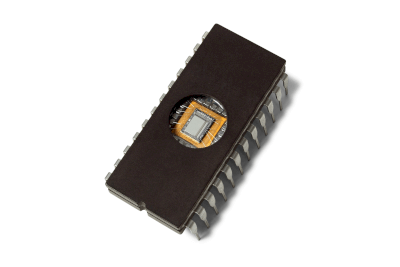What Is a Mask ROM?

A mask ROM is a type of read-only memory (ROM) where the memory content is predetermined during the manufacturing process at a semiconductor plant.
In semiconductor memory classification, ROM falls into two categories: mask ROM and programmable ROM. Unlike programmable ROMs, mask ROMs cannot be erased or rewritten after manufacturing.
Mask ROMs are cost-effective for mass production and prevent unauthorized rewriting of programs post-shipment. However, they pose challenges for post-manufacturing modifications due to the lengthy development and manufacturing periods.
Uses of Mask ROMs
Mask ROMs, being immutable once shipped, find applications as fixed data memory for control programs in embedded devices, microcode for CPUs, game software, kanji fonts, dictionary data, and more.
Due to the inability to easily correct bugs post-production, programmable ROMs are often used during system development, with the finalized data then sent to a memory manufacturing facility to produce mask ROMs.
Principle of Mask ROMs
Mask ROMs come in two main structures: NAND type and NOR type. The NAND type features transistors connected in series, while the NOR type has transistors connected in parallel. Both types consist of a grid of word lines and bit lines, with each memory cell represented by a transistor.
The data is written to the mask ROM during the semiconductor wafer fabrication process. Each transistor’s content is set to 1 or 0 during this process, and once written, the data remains unchanged.
To read data, the word line connected to the cell to be read is activated, and the other word lines are deactivated. The current in the bit line connected to the cell is then detected, with a current indicating a 1 and no current indicating a 0.
Types of Mask ROMs
Mask ROMs employ three methods for writing data: diffusion, contact, and ion implantation.
1. Diffusion Method
Applicable to the NOR type, where only transistors with data 1 are formed on the wafer, omitting transistors with data 0. However, it sees limited use due to the extended manufacturing time.
2. Contact Method
Also applicable to the NOR type, this method involves not connecting the source of transistors with data 0 to the bit line. Its manufacturing time is shorter as it depends on whether contact holes connecting transistors and wiring are made in the latter half of the wafer process.
3. Ion Implantation Method
Compatible with both NAND and NOR types, this method implants ions into transistors to alter their threshold voltages. Transistors with relatively high threshold voltages are set to 0, while those with low threshold voltages are set to 1.
How to Choose Mask ROMs
Aside from mask ROMs, EEPROM and flash memory are also available as ROM types, each with its advantages and disadvantages.
1. EEPROM
This ROM type allows users to rewrite its contents. It can be used for both reading and writing operations without special procedures, making it suitable for recording computer configuration information.
2. Flash Memory
Flash memory enables easy writing and erasing of data, with contents retained even when power is off. Commonly used in memory cards and USB flash drives for storing data.
3. Advantages of Mask ROM
Lower production costs compared to flash memory and EPROM. Simpler peripheral circuits and cell structures result in high integration levels among semiconductor memories.
4. Disadvantages of Mask ROM
Initial costs for mask development are required. The manufacturing process takes several days to a month to start mass production. Altering recording contents necessitates remaking the mask, and program updates like bug fixes are challenging.